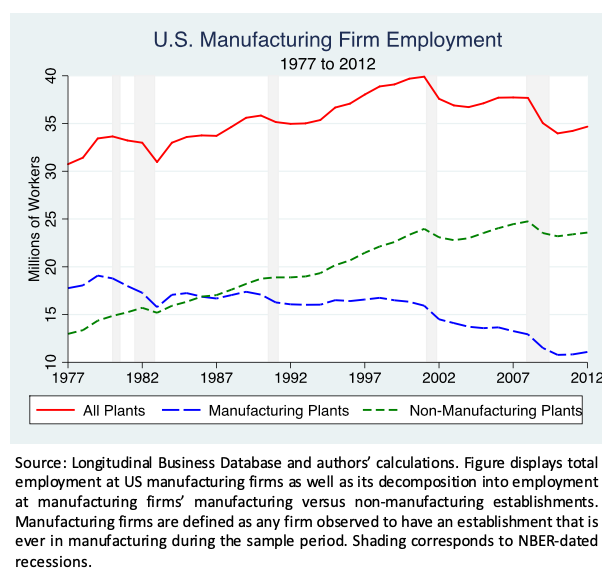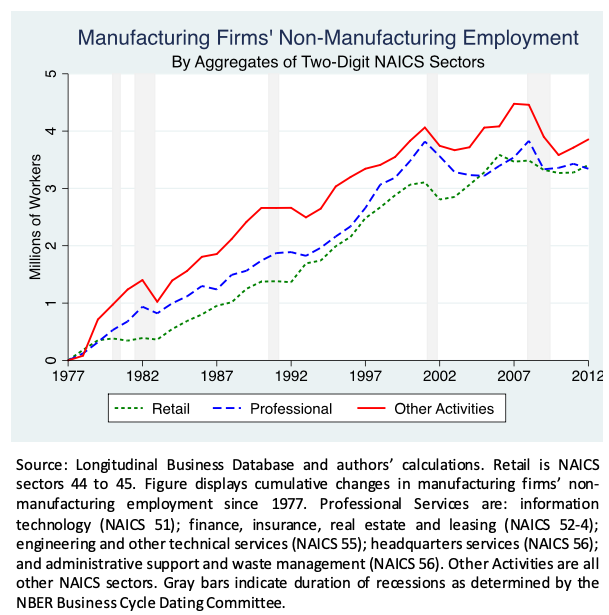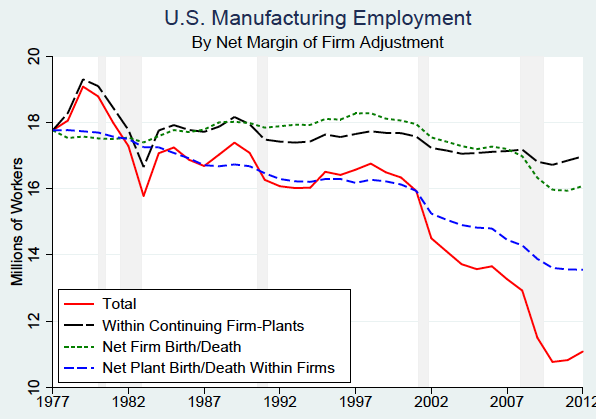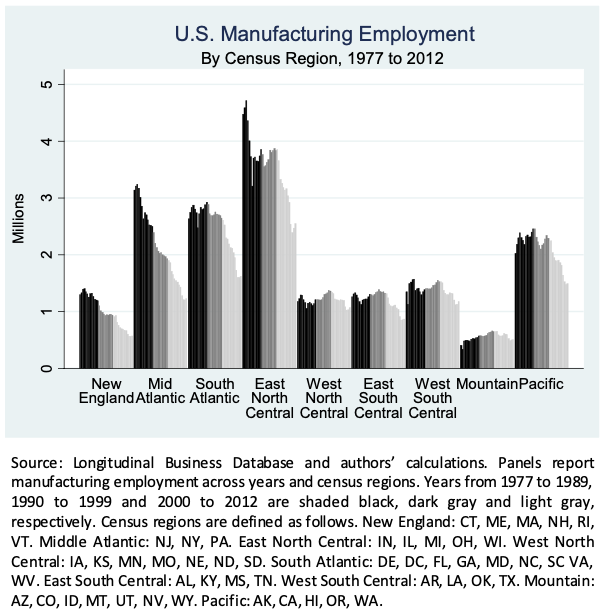US manufacturing employment has been falling since 1979, with particularly sharp declines in 2001 and 2007. There is considerable debate as to whether this trend is driven by international trade (Bernard et al. 2006, Autor et al. 2013, Autor et al. 2016, Pierce and Schott 2016) or the introduction of new, labour-saving technologies (Rowthorn and Ramaswamy 1999, Edwards and Lawrence 2013). While we feel that these factors are exceedingly difficult to disentangle, we argue in Fort et al. (2018) that examining how and where the decline in US manufacturing employment occurs provides insight into how this sector is changing, as well as potential policy responses to the job losses.
We highlight three trends apparent in the US manufacturing sector.
- First, the decline in manufacturing firms’ manufacturing employment since its peak in 1979 is more than offset by an increase in their non-manufacturing employment, particularly in retail and business services, though this growth flattens after 2000.
- Second, the majority of the manufacturing employment decline occurs due to plant closure within continuing firms rather than from firm exit.
- Third, US manufacturing employment losses are particularly severe in the north and east due to spatial reallocation towards the south and west between 1977 and 2000. Combined with previous research demonstrating a concomitant increase in US manufacturing real value added (Houseman et al. 2011), these trends suggest substantial increases in labour productivity, and an evolution of US manufacturing in line with US comparative advantage.
Data
Our analysis exploits the US Census Bureau’s Longitudinal Business Database, which tracks the employment of all private, non-farm US employers at the establishment level from 1977 to 2012. In these data, as in most national statistics, employees are grouped into industries based upon classification of the establishment at which they work. As a result, all employees in a manufacturing plant are classified as manufacturing employees, regardless of their occupation. Manufacturing firms, which we identify broadly as firms that ever possess a manufacturing establishment between 1977 and 2012, have observable non-manufacturing employment if their set of establishments includes non-manufacturing establishments.
First trend
Figure 1 shows that manufacturing firms lose 6.7 million manufacturing workers between 1977 and 2012. During this period, however, they gain 10.6 million non-manufacturing workers. Before 2000, manufacturing firms’ total employment rises, on net. After 2000, the growth of non-manufacturing employment flattens, while losses in manufacturing employment accelerate. As a result, manufacturing firms’ total employment begins to decline.
Figure 1 US manufacturing firm employment, 1977-2012
Figure 2 reports a breakdown of the gains in non-manufacturing employment by broad sector, revealing that retail and business services each account for approximately one-third of the growth. This growth brings to mind some of the US’ most-storied firms. Apple, for example, has transitioned from a ‘manufacturer’ of personal computers and consumer electronic devices into a ‘neurofacturer’ (Leamer 2009, Bernard et al. 2018) that orchestrates the design, marketing, and retailing of these devices, leaving their physical production to foreign contractors. Likewise, IBM has transformed itself almost completely into a provider of consulting services. As noted above, our sample includes firms not traditionally thought of as manufacturers, and that such firms influence the trends in non-manufacturing employment.
Figure 2 Manufacturing firms’ non-manufacturing employment by aggregates of two-digit NAICS sectors
Second trend
Although US manufacturing employment declines by 6.7 million workers from 1977 to 2012, firm death plays a relatively small role. The solid line in Figure 3 displays the total decline in manufacturing firms’ manufacturing employment displayed in Figure 1. The remaining lines decompose that total into three margins of firm adjustment: net firm death, net plant death among continuing firms, and net decline among continuing firm-plants. As indicated in the Figure, 75% of the overall decline occurs along the second and third margins, that is, within continuing firms. Within those two margins, net plant death among continuing firms accounts for the overwhelming majority, 63% of the total.
Figure 3 US manufacturing employment by net margin of firm adjustment
The fact that net firm death accounts for just 25% of the cumulative drop is a surprising outcome given conventional beliefs about the advantages disruptive entrants have over ossified incumbents (Christensen 1997). The importance of net establishment death within continuing firms, however, suggests that creative destruction is alive and well, but that it takes place to an even greater extent within – rather than across – firms.
One rationale for this form of creative destruction is that adopting new production technologies (Ganapati 2018) or products (Bernard et al. 2006) in response to import competition or other shocks entails the payment of high fixed costs that only the largest (continuing) firms can bear, and that these changes are easier to implement in new versus existing plants, perhaps in a different region (see below). Consistent with this view, we find in a series of descriptive regressions that firms are more likely to shut down plants that use outmoded technology or have a product mix less insulated from import competition. We also find that firms that use advanced technologies exhibit size and productivity premia similar to what has been documented for exporters. Recent work by Boehm et al. (2019) finds that US multinational enterprises account for 40% of the decline in US manufacturing employment from 1993 to 2011, and that plant closures form a significant part that of that decline. These findings beg for more research into how these firms – like Apple and IBM – manage (or cause) structural change.
Third trend
Figure 4 plots US manufacturing employment by Census region and year, depicting its movement from the north and east to the south and west up until to 2000. Indeed, from 1977 to 2000, manufacturing employment in New England, Mid-Atlantic, and East North Central declines by 2.3 million, while increasing by 0.8 million in the remaining regions. This reallocation likely reflects a number of forces, including firms’ search for lower wages within the US, as well as lower operating, construction, real estate costs, and population growth. Crafts and Klein (2017), for example, argue that the southern movement of US auto plants starting in the 1960s was a response to two factors: a reduction in transport costs and the choice of Japanese producers, who sought lower wages in Kentucky and Tennessee.
Figure 4 US manufacturing employment by Census region, 1977-2012
After 2000, manufacturing employment shrinks in all regions, reflecting at least in part the sharp rise in import competition from China that begins in that year (Autor et al. 2013; Pierce and Schott 2016). Figure 5, by contrast, shows that manufacturing firms’ non-manufacturing employment grows in all regions, though it is particularly strong in the South Atlantic region.
Figure 4 also shows that although net firm death accounts for just 25% of the aggregate decline in manufacturing employment between 1977 and 2012, it is concentrated in New England and Mid-Atlantic. Together, these regions account for two-thirds of the decline in US manufacturing employment attributable to net firm death. These regions also experience the smallest growth in manufacturing firms’ non-manufacturing employment. This outcome suggests New England and Mid-Atlantic experienced particularly severe destruction of firm-specific intangible capital, since their manufacturing firms exit entirely instead of growing in other sectors.
Figure 5 Manufacturing firms’ non-manufacturing employment by Census region, 1977-2012
Conclusion
Manufacturing firms’ non-manufacturing activities are worthy of greater scrutiny. While the decline in US manufacturing garners considerable attention, manufacturing firms’ expansion into services suggests the presence of valuable capabilities that can be – and are being – redeployed into other sectors. At the same time, workers losing jobs in the manufacturing sector may face difficulties in finding employment in the growing nonmanufacturing sector if those jobs require different skills or are located in different geographic areas. The most effective policies would encourage manufacturing firms to exploit new trade and technology opportunities, while easing the transition to re-employment for displaced workers.
References
Acemoglu, D and P Restrepo (2017), “Robots and Jobs: Evidence from US Labor Markets”, NBER Working Paper 23285.
Autor, D H, D Dorn and G H Hanson (2013), “The China Syndrome: Local Labor Market Effects of Import Competition in the United States”, American Economic Review 103(6): 2121–68.
Autor, D H, D Dorn, G H Hanson and J Song (2014), “Trade Adjustment: Worker Level Evidence”, Quarterly Journal of Economics 129(4): 1799–1860.
Bernard, A B and T C Fort (2015), “Factoryless Goods Producing Firms”, American Economic Review 105(5): 518–23.
Bernard, A B, J B Jensen and P K Schott (2006), “Survival of the Best Fit: Exposure to Low-Wage Countries and the (Uneven) Growth of U.S. Manufacturing Plants”, Journal of International Economics 68(1): 219–37.
Bernard, A B, S J Redding and P K Schott (2013), “Testing for Relative Factor Price Equality with Unobserved Differences in Factor Quality or Productivity”, American Economic Journal: Microeconomics 5(2): 135–63.
Bernard, A B, T C Fort, V Smeets and F Warzynski (2018), “Heterogeneous Globalization: Offshoring and Reoganization”.
Boehm, C, A Flaaen and N Pandalai-Nayar (2019), “A new assessment of the role of offshoring in the decline in US manufacturing employment”, VoxEU.org, 15 August.
Boehm, C, A Flaaen and N Pandalai-Nayar (2019), “Multinationals, offshoring and the decline of U.S. manufacturing”, NBER working paper 25824.
Christensen, C M (1997), The Innovator’s Dilemma, New York: HarperBusiness.
Cowie, J (1999), Capital Moves: RCA’s Seventy-Year Quest for Cheap Labor, Ithaca, NY: Cornell University Press.
Crafts, N and A Klein (2017), “Moving around: The changing geography of US manufacturing during the 20th century”, VoxEU.org, 12 December.
Crafts, N and A Klein (2017), “A Long-Run Perspective on the Spatial Concentration of Manufacturing Industries in the United States”, CEPR Discussion Paper No. 12257.
Edwards, L and R Z Lawrence (2013), Rising Tide: Is Growth in Emerging Economies Good for the United States?, Washington, DC: Peterson Institute for International Economics.
Fort, T C (2017), “Technology and Production Fragmentation: Domestic versus Foreign Sourcing”, Review of Economic Studies 84(2): 650–87.
Fort, T, J R Pierce and P K Schott (2018), “New Perspectives on the Decline of US Manufacturing Employment”, Journal of Economic Perspectives 32(2): 47–72
Ganapati, S (2018), “The Modern Wholesaler: Global Sourcing, Domestic Distribution, and Scale Economies”, Georgetown University Working Paper.
Haltiwanger, J, R S Jarmin and J Miranda (2013), “Who Creates Jobs? Small versus Large versus Young”, Review of Economics and Statistics 95(2): 347–61.
Handley, K and N Limão (2017), “Policy Uncertainty, Trade, and Welfare: Theory and Evidence for China and the United States”, American Economic Review 107(9): 2731–83.
Houseman, S, C Kurz, P Lengermann and B Mandel (2011), “Offshoring Bias in U.S. Manufacturing”, Journal of Economic Perspectives 25(2): 111–32.
Leamer, E (2009), “Heckscher-Ohlin Models for the Post-Industrial Age”, UCLA Working Paper.
Magyari, I (2017), “Firm Reorganization, Chinese Imports, and US Manufacturing Employment”, Working Paper 17-58, Center for Economic Studies, US Census Bureau.
Pierce, J R and P K Schott (2016), “The Surprisingly Swift Decline of U.S. Manufacturing Employment.” American Economic Review 106(7): 1632–62.
Ramaswamy, R R (1999), “Growth, trade, and deindustrialization”, International Monetary Fund Staff Papers 46, 18–41.












